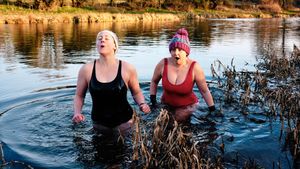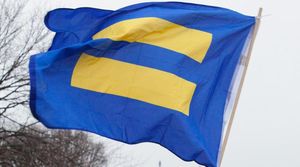Winter is nearly upon us, and for those who have often gazed at the night sky, it's not just the stars or the changing phases of the moon drawing our attention. This season brings increased chances of witnessing one of nature's most mesmerizing phenomena: the northern lights, or aurora borealis. Thanks to the peaks of solar activity anticipated this winter, many across the northern hemisphere may soon be treated to these stunning displays of green and red hues dancing across the sky.
The excitement builds with the forecast from the National Oceanic and Atmospheric Administration (NOAA), which indicates we are currently experiencing the solar maximum of Solar Cycle 25. This means we're entering what is expected to be an elevated period of solar activity, characterized by more frequent solar storms capable of casting the auroras at unusually low latitudes, far beyond their typical play areas.
Shawn Dahl, a service coordinator with NOAA, explains, "What this means is we anticipate having additional solar storms known as geomagnetic storms, which could lead to aurora manifestations at lower latitudes than normal." His message resonates with stargazers eager to know when and where they might catch the vibrant auroras illuminating their night skies. The predictions suggest heightened aurora activity lasting not just this winter, but potentially extending through to 2025, accompanied by exciting celestial events like meteor showers.
For many, the anticipation of vibrant colors splashed across the sky isn’t just about beauty but also about the stories and memories associated with the experience. Residents from regions typically known for short, dark winter days provide testimonials of their past encounters. For example, Alison Andrews from Gloucestershire fondly recalls her great-aunt's description of witnessing the northern lights, who spoke of hearing fizzing and buzzing encapsulated within vibrant visuals. It’s not uncommon for many to think the auroras are soundless, yet some claim to experience subtle auditory sensations during these light shows.
Indeed, for decades, the notion of the northern lights producing sound was dismissed as mere superstition or illusion. But scientists are now exploring these auditory claims with increased seriousness. The Auroral Acoustics program, which has been investigating auroral sound phenomena for the past two decades, captured crackling and whistling echoes accompanying the northern lights. Professor Unto K. Laine from Aalto University hypothesizes these unique noises are caused by electrical discharges occurring 70 to 100 meters above the earth, providing new avenues for captivating scientific inquiry.
Across the globe, stories of the northern lights spur more than just personal reflection; they ignite curiosity among communities and science enthusiasts. Social media abounds with videos and images of the auroras, with some individuals even believing they’ve caught the peculiar sound of the lights through their recordings. For example, Anika Dhanda from Hillingdon described her experience of feeling the lights as akin to “clicky rain,” showcasing how individual perceptions deepen the connection with these celestial wonders.
On the American front, as communities keep their eyes peeled for potential aurora sightings, specific locations like the Morley Nelson Snake River Birds of Prey National Conservation Area and the Boise Mountains have garnered attention. The lessened light pollution makes these locales prime for sky-watching. Dave Groenert, lead meteorologist at the National Weather Service, notes, "If the aurora borealis is visible only on the horizon, it’s unlikely anyone south of the Boise Mountains can watch it. But if they are strong enough, they may even arc over the horizon, making them visible to folks within the city areas," bringing excitement to those accustomed to light-laden urban environments.
Such exciting possibilities arrive amid the backdrop of meteor showers expected to peak this winter. The Geminids meteor shower, which usually delivers around 100 meteors per hour at its peak, is set to take the spotlight around December 13-14. Dahl encourages the public to set aside some time under the dark winter sky to not only seek auroras but also to witness these ethereal meteor displays. The Quadrantids meteor shower follows shortly after, likely to peak on January 2-3, but it may arrive accompanied by fickle weather and brief visibility windows, adding to the challenge and excitement of the spectacle.
The return of the northern lights mingling with the significant meteor activity should motivate adventure among stargazers and science enthusiasts alike. The mingling of celestial events offers reassurance to amateur astronomers and seasoned observers alike. Whether the aurora displays are intense or subtle, we see individuals being drawn from cities and rural communities alike to witness these awe-inspiring spectacles of light.
Social media platforms ignite enthusiasm, where hashtags related to aurora sightings and star-gazing not only serve as community builders but create shared experiences across the globe. Reports of lights being visible as far south as places like Texas and Florida indicate the cosmic dance may soon transcend traditional boundaries, bringing together people who wish to marvel at these natural wonders.
It’s clear; winter is shaping up to be unforgettable, not just for the celestial phenomena, but for the stories, experiences, and connections people share as they bundle up against the cold to seek enlightenment from above. All eyes toward the heavens may soon lead to joyous discoveries of glowing colors and potential whispers from the stars, weaving the fabric of human experiences bright with fascination.
This winter, amid chilly nights and crisp air, there’s no doubt the northern lights' great spectacle could fulfill dreams of many. From hushed voices marveling at shimmering skies to scientific minds unraveling the mysteries of sound colliding with light, this season of auroras is primed to captivate hearts and awaken wonder.



